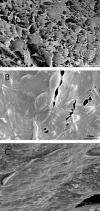Chondrogenic Differentiation of Human Umbilical Cord Blood-Derived Unrestricted Somatic Stem Cells on A 3D Beta-Tricalcium Phosphate-Alginate-Gelatin Scaffold
- PMID: 24518974
- PMCID: PMC3933438
Chondrogenic Differentiation of Human Umbilical Cord Blood-Derived Unrestricted Somatic Stem Cells on A 3D Beta-Tricalcium Phosphate-Alginate-Gelatin Scaffold
Abstract
Objective: Finding cell sources for cartilage tissue engineering is a critical procedure. The purpose of the present experimental study was to test the in vitro efficacy of the beta-tricalcium phosphate-alginate-gelatin (BTAG) scaffold to induce chondrogenic differentiation of human umbilical cord blood-derived unrestricted somatic stem cells (USSCs).
Materials and methods: In this experimental study, USSCs were encapsulated in BTAG scaffold and cultured for 3 weeks in chondrogenic medium as chondrogenic group and in Dulbecco's Modified Eagle's Medium (DMEM) as control group. Chondrogenic differentiation was evaluated by histology, immunofluorescence and RNA analyses for the expression of cartilage extracellular matrix components. The obtain data were analyzed using SPSS version 15.
Results: Histological and immunohistochemical staining revealed that collagen II was markedly expressed in the extracellular matrix of the seeded cells on scaffold in presence of chondrogenic media after 21 days. Reverse transcription-polymerase chain reaction (RT-PCR) showed a significant increase in expression levels of genes encoded the cartilage-specific markers, aggrecan, type I and II collagen, and bone morphogenetic protein (BMP)-6 in chondrogenic group.
Conclusion: This study demonstrates that BTAG can be considered as a suitable scaffold for encapsulation and chondrogenesis of USSCs.
Keywords: Chondrogenesis; Mesenchymal Stem Cells; Scaffold.
Copyright © 2014. Published by Royan Institute (ACECR).The full text is avalible in: www.celljournal.org.
Figures






Similar articles
-
Chondrogenic differentiation of ATDC5 and hMSCs could be induced by a novel scaffold-tricalcium phosphate-collagen-hyaluronan without any exogenous growth factors in vitro.J Biomed Mater Res A. 2014 Aug;102(8):2725-35. doi: 10.1002/jbm.a.34948. Epub 2013 Sep 24. J Biomed Mater Res A. 2014. PMID: 24026971
-
Comparison of the Chondrogenic Potential of Mesenchymal Stem Cells Derived from Bone Marrow and Umbilical Cord Blood Intended for Cartilage Tissue Engineering.Stem Cell Rev Rep. 2020 Feb;16(1):126-143. doi: 10.1007/s12015-019-09914-2. Stem Cell Rev Rep. 2020. PMID: 31745710
-
Osteogenic and chondrogenic differentiation by adipose-derived stem cells harvested from GFP transgenic mice.Biochem Biophys Res Commun. 2004 Jan 23;313(4):871-7. doi: 10.1016/j.bbrc.2003.12.017. Biochem Biophys Res Commun. 2004. PMID: 14706623
-
Chondrogenesis of periodontal ligament stem cells by transforming growth factor-β3 and bone morphogenetic protein-6 in a normal healthy impacted third molar.Int J Oral Sci. 2013 Mar;5(1):7-13. doi: 10.1038/ijos.2013.19. Epub 2013 Apr 12. Int J Oral Sci. 2013. PMID: 23579467 Free PMC article.
-
Modulation of chondrogenic differentiation of human mesenchymal stem cells in jellyfish collagen scaffolds by cell density and culture medium.J Tissue Eng Regen Med. 2017 Jun;11(6):1710-1722. doi: 10.1002/term.2065. Epub 2015 Jul 14. J Tissue Eng Regen Med. 2017. PMID: 26178016
Cited by
-
Ameliorating effect of encapsulated hepatocyte-like cells derived from umbilical cord in high mannuronic alginate scaffolds on acute liver failure in rats.Iran J Basic Med Sci. 2018 Sep;21(9):928-935. doi: 10.22038/IJBMS.2018.27928.6847. Iran J Basic Med Sci. 2018. PMID: 30524693 Free PMC article.
-
Effects of Silymarin-Loaded Nanoparticles on HT-29 Human Colon Cancer Cells.Medicina (Kaunas). 2018 Mar 9;54(1):1. doi: 10.3390/medicina54010001. Medicina (Kaunas). 2018. PMID: 30344232 Free PMC article.
-
Human Menstrual Blood-Derived Endometrial Stem Cells Promote Functional Recovery by Improving the Inflammatory Microenvironment in a Mouse Spinal Cord Injury Model.Cell Transplant. 2023 Jan-Dec;32:9636897231154579. doi: 10.1177/09636897231154579. Cell Transplant. 2023. PMID: 36786359 Free PMC article.
-
Hypoxia Is a Critical Parameter for Chondrogenic Differentiation of Human Umbilical Cord Blood Mesenchymal Stem Cells in Type I/III Collagen Sponges.Int J Mol Sci. 2017 Sep 8;18(9):1933. doi: 10.3390/ijms18091933. Int J Mol Sci. 2017. PMID: 28885597 Free PMC article.
-
Manipulation of a quasi-natural cell block for high-efficiency transplantation of adherent somatic cells.Braz J Med Biol Res. 2015 May;48(5):392-400. doi: 10.1590/1414-431X20144322. Epub 2015 Mar 3. Braz J Med Biol Res. 2015. PMID: 25742639 Free PMC article.
References
-
- Johnstone B, Yoo JU. Autologous mesenchymal progenitor cells in articular cartilage repair. Clin Orthop Relat Res. 1999;367(Suppl):S156–162. - PubMed
-
- Coleman RM, Case ND, Guldberg RE. Hydrogel effects on bone marrow stromal cell response to chondrogenic growth factors. Biomaterials. 2007;28(12):2077–2086. - PubMed
-
- Temenoff JS, Mikos AG. Tissue engineering for regeneration of articular cartilage. Biomaterials. 2000;21(5):431–440. - PubMed
-
- Solchaga LA, Goldberg VM, Caplan AI. Cartilage regeneration using principles of tissue engineering. Clin Orthop Relat Res. 2001;391(Suppl):161–170. - PubMed
-
- Homicz MR, Schumacher BL, Sah RL, Watson D. Effects of serial expansion of septal chondrocytes on tissue-engineered neocartilage composition. Otolaryngol Head Neck Surg. 2002;127(5):398–408. - PubMed
LinkOut - more resources
Full Text Sources
